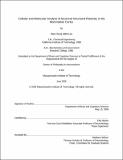| dc.contributor.advisor | Elly Nedivi. | en_US |
| dc.contributor.author | Lee, Wei-Chung Allen | en_US |
| dc.contributor.other | Massachusetts Institute of Technology. Dept. of Brain and Cognitive Sciences. | en_US |
| dc.date.accessioned | 2006-11-06T10:27:39Z | |
| dc.date.available | 2006-11-06T10:27:39Z | |
| dc.date.copyright | 2006 | en_US |
| dc.date.issued | 2006 | en_US |
| dc.identifier.uri | http://hdl.handle.net/1721.1/34275 | |
| dc.description | Thesis (Ph. D.)--Massachusetts Institute of Technology, Dept. of Brain and Cognitive Sciences, 2006. | en_US |
| dc.description | This electronic version was submitted by the student author. The certified thesis is available in the Institute Archives and Special Collections. | en_US |
| dc.description | Includes bibliographical references (p. 87-100). | en_US |
| dc.description.abstract | Despite decades of evidence for functional plasticity in the adult brain, the role of structural plasticity in its manifestation remains unclear. cpg15 is an activity-regulated gene encoding a membrane-bound ligand that coordinately regulates growth of apposing dendritic and axonal arbors and the maturation of their synapses. Here we compare cpg15 expression during normal development of the rat visual system, with that seen in response to dark rearing, monocular retinal action potential blockade, or monocular deprivation. Our results show that: (1) cpg15 expression in visual cortex correlates with the electrophysiologically mapped critical period for development of eye-specific preference in the primary visual cortex. (2) Dark rearing elevates adult levels of expression. (3) A component of cpg15 expression is activity-dependent after the peak of the critical period. (4) At the peak of the critical period, monocular deprivation decreases cpg15 expression more than monocular TTX blockade. And (5) cpg15 expression is robust and regulated by light in the superficial layers of the adult visual cortex. | en_US |
| dc.description.abstract | (cont.) This suggests that cpg15 is an excellent molecular marker for the visual system's capacity for plasticity and predicts that neural remodeling normally occurs in the extragranular layers of the adult visual cortex. To examine the extent of neuronal remodeling that occurs in the brain on a daily basis, we used a multi-photon based microscopy system for chronic in vivo imaging and reconstruction of entire neurons in the superficial layers of the rodent cerebral cortex. Here, we show the first unambiguous evidence of dendrite growth and remodeling in adult neurons. Over a period of months, neurons could be seen extending and retracting existing branches, and in rare cases adding new branch tips. Neurons exhibiting dynamic arbor rearrangements were GABA positive non-pyramidal interneurons, while pyramidal cells remained stable. These results are consistent with the idea that dendritic structural remodeling is a substrate for adult plasticity and suggest that circuit rearrangement in the adult cortex is restricted by cell type-specific rules. | en_US |
| dc.description.statementofresponsibility | by Wei-Chung Allen Lee. | en_US |
| dc.format.extent | 100 p. | en_US |
| dc.format.extent | 5924494 bytes | |
| dc.format.extent | 5924232 bytes | |
| dc.format.mimetype | application/pdf | |
| dc.format.mimetype | application/pdf | |
| dc.language.iso | eng | en_US |
| dc.publisher | Massachusetts Institute of Technology | en_US |
| dc.rights | M.I.T. theses are protected by copyright. They may be viewed from this source for any purpose, but reproduction or distribution in any format is prohibited without written permission. See provided URL for inquiries about permission. | en_US |
| dc.rights.uri | http://dspace.mit.edu/handle/1721.1/7582 | |
| dc.subject | Brain and Cognitive Sciences. | en_US |
| dc.title | Cellular and molecular analysis of neuronal structure plasticity in the mammalian cortex | en_US |
| dc.type | Thesis | en_US |
| dc.description.degree | Ph.D. | en_US |
| dc.contributor.department | Massachusetts Institute of Technology. Department of Brain and Cognitive Sciences | |
| dc.identifier.oclc | 71331402 | en_US |
